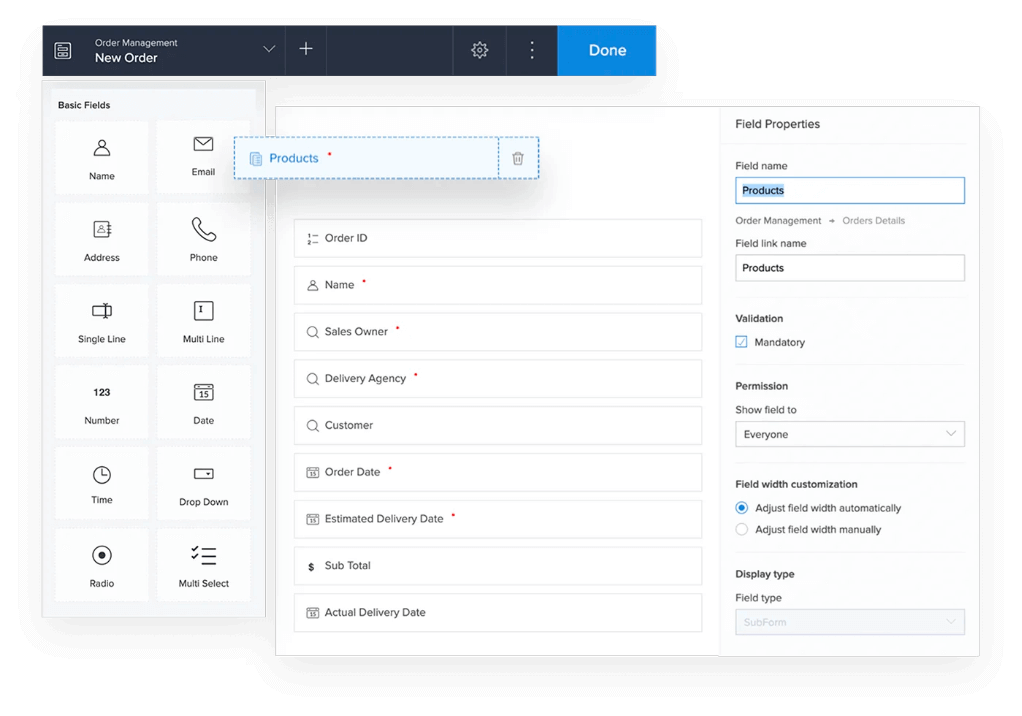Top Suggestions For Choosing application development with Low-code platforms
Wiki Article
Benefits Of Developing Applications Using Low-Code In Terms Of Integration Capabilities
Low-code development is a great method to create applications that seamlessly integrate with various systems and services. Here are key benefits from pre-built connectors, APIs as well as other tools:
Wide Selection of Connectors. Low-code systems typically include many pre-built connections for business systems that are well-known (e.g. cloud services, databases and CRM). This simplifies the process of integrating with these systems.
API Integration: A lot of low-code platforms have integrated APIs that are built-in that allow developers to easily connect with external data sources and services.
Ease Of Use
Drag-and-Drop Integration Tasks for integration can typically be completed using drag-and-drop interfaces, which makes it easy for both developers and non-developers to design complicated integrations without writing a lot of code.
Visual Workflow builders Visual Workflow Builders: These tools can be designed to create workflows, data flows, and integrations. They assist in understanding and setting up workflows more easily.
Standardized Integration Methods:
SOAP/RESTful Services Support: Standard web services protocols, like SOAP/REST, allow for easy integration of various external applications and systems.
OData and various Standards Standardization like OData permits the easy access and manipulation of data on various platforms and applications.
Real-Time Data Synchronization:
Real-time Integrations: Low-code platforms allow real-time data synchronization between applications and systems, making sure that data is always current and consistent across the organization.
Event-Driven architecture: Certain platforms support event driven architectures. This lets applications react to events in real-time and is crucial for interactive and dynamic apps.
Legacy System Integration:
Low-code platforms: These can be utilized to connect old systems to the latest. They are a great option to modernize your IT infrastructure without having to overhaul everything.
Data Migration Tools: Built-in data migration tools aid in the transfer of data from old systems to new applications built using low-code platforms.
Integration of Third-Party services:
Cloud Services: Integration with cloud services like AWS Azure and Google Cloud allows easy deployment and scaling.
Integration of Business Applications Lowcode platforms are used to integrate different business applications including Salesforce, SAP, Microsoft Dynamics etc., creating a cohesive workflow among different business functions.
Simplified Data Processing
Unified Data Models: A few lowcode platforms offer unification of coding models that simplify managing data as well as integration and synchronization between different systems.
Data Connectors Pre-configured data connectors allow you to easily access and manipulate data from various sources.
Security and compliance:
Secure Integrations: Low-code platforms guarantee that integrations adhere to security protocols and standards, protecting data during transport as well as at rest.
Compliance Features: These platform usually have features to ensure that the integrations meet regulations, for example GDPR and HIPAA. This gives peace ofmind for businesses handling sensitive data.
Extensibility:
Custom Codes and Scripts. For more complex needs in integration, low-code platforms often allows the inclusion custom code and scripts. This gives flexibility but without compromising user convenience.
Plug-in Ecosystems : An eco system of plugins and extensions allows users to expand the integration capabilities. They can add new features as they need.
The overall low-code platform's capabilities for integration make it a powerful instrument to create interconnected applications that are efficient and scalable. These platforms simplify the process of connecting various IT systems, improve the flow of data, and aid businesses to adopt the latest technologies as well as leveraging new technologies. Read the top rated continue reading on Low-code Platform for application development for website tips including cross platform mobile development, app platforms, mobile development platforms, developing mobile apps, cross platform app development, push notifications android, rapid action development, app platforms, cross platform mobile dev, rad development and more.

Low-Code Apps Are Affordable.
Low-code application development offers numerous advantages when it comes to cost-efficiency, making it an attractive alternative for companies seeking to reduce their development costs while delivering high-quality applications. Here are a few of the key benefits.
Lower Coding Requirements: Low programming platforms eliminate the requirement to write code manually and save developers time and money. This means lower costs for labor.
Less developers: Since low-code development is quicker and simpler, there are fewer specialized developers needed. This can cut down on hiring and staffing costs.
Speedier Time to Market
Rapid development process: Visual development tools and pre-built components offered by low-code platforms facilitate rapid development of applications. This allows companies to get their products to market quicker. This can lead to increased revenue and a better position in the marketplace.
Rapid Prototyping: Businesses can develop and test prototypes in a very short amount of time, which reduces the amount of time required to develop. This allows them to create faster iterations after receiving user feedback.
Lower maintenance costs:
Due to their modular structure and common components, low-code platforms generally allow for easier maintenance of applications. It reduces costs for maintenance and support.
Automated updates: A lot of low-code platforms automate updates and patches, making sure that applications are secure and current with no need for a lengthy manual intervention.
Efficient Resource Utilization:
Contributions from non-developers: Low code platforms allow non-developers, for example, business users to contribute to the development process. This decentralization of the development process permits companies to tap into the expertise and expertise of a greater variety of employees.
Improved utilization of IT resources: IT departments have the opportunity to focus on more strategic projects, instead of being sucked into mundane work tasks for development. Overall productivity and efficiency improves.
Price models that can be scaled:
Subscription-Based Price: Many low code platforms offer an affordable subscription-based pricing model that grows with usage. This allows businesses to match their spending to their actual needs and increase.
Pay-Asyou-Go Options - Some platforms allow companies to pay for only the amount they spend. This is particularly beneficial for small or new businesses with a limited budget.
Reduced Third-Party Software costs:
Built-in Functionalities : A low-code platforms usually comes with built-in functionality and integrations which reduces the requirement for additional third-party software, tools, and licenses.
Integrations pre-built: These pre-built systems and services are integrated with other well-known services, reducing the need for custom-built software, which saves time and cost.
Higher ROI
A faster return on investment: The combination of rapid development, lower costs, and a faster time to market, means that businesses will see a higher ROI (ROI) for their software.
Improved Agility - Businesses are able to quickly adjust to changes in the market and changing customer needs. This lets them stay relevant and capitalize on opportunities that arise.
Train for less:
User-Friendly Interfaces: The user-friendly interfaces and user-friendly functions of low-code platforms help to reduce the learning curve, eliminating the need for intensive training.
Accessible Resources that are accessible. A lot of low-code platforms offer complete training materials including tutorials, training, and community support. They reduce the need to undergo formal training, which can be costly.
Collaboration can be streamlined.
Enhanced Collaboration Tools: The collaboration tools built-in to the software aid in communication and coordination between team members. This leads to a more efficient project development process and lower overhead.
Unified Development Environment (UDE): A single, unified development environment streamlines processes and cuts cost and complexity that comes with managing various tools and platforms.
Overall, the efficiency of low-code software development is due to its capability to lower the cost of maintenance and development as well as increase the time to market and optimize the use of resources and offer flexible pricing models. Low-code can provide significant financial benefits to businesses. Read the recommended Legacy application modernization with Low-code url for site advice including app dev platform, azure sql, database in azure, rad application development, rad application development, rapid applications, rad application development, multiplatform mobile app development, rapid applications, rapid action development and more.

Benefits Of Low-Code App Development With Respect To Limitations And Customization
Low-code development is a balanced approach that provides substantial advantages when it comes to solving limitations and allowing customisation. Here are a few principal benefits: Handling limitations:
: .
Simple development: Platforms that use low-code cut down on the complexity of development by providing templates and components pre-built for you, enabling quicker development and deployment for complex applications.
Guided Workflows Many platforms offer workflows and wizards that help developers through complex processes. This helps to reduce the risk of making mistakes and ensures uniformity.
Scalability Solutions
Built-in Scalability: Low code platforms have many features that allow for the design of scalable architecture, which allows applications to cope with increased demand without requiring significant changes.
Performance Monitoring: Integrated tools for monitoring performance and optimization ensure that applications remain efficient as they expand.
Security and compliance
Low-code platforms come with security features such as role-based security access control, encryption, and automated checks for security compliance. These measures address the common concerns about security.
Platforms are constantly updating their security protocols and ensure that they are in compliance with the regulatory requirements. This helps keep the applications secure from threats that are constantly evolving.
Customization:
Extensibility:
Low-code platforms allow custom code They allow the integration and the use of custom code.
Custom Plugins and Moduls Developers can create custom plug-ins or modules that provide specific functionality that are tailored to the specific requirements of a particular business.
APIs Integration:
API Support: Full API support is available to facilitate seamless integration and connection with other systems.
Third-Party Applications: Lowcode platforms are often already built with connectors to third-party applications, which makes it easier to integrate these applications and personalize the application.
Flexible UI/UX:
Flexible User Interfaces for Developers: Designers have the ability to modify and design user interfaces to meet certain design and usability specifications and provide a customized user experience.
Responsive Designs: The applications can be customized to suit various screen sizes and devices.
Customizing Business Logic is easy:
Visual Workflow Builders This tool lets developers create complex processes with little or no programming. They can create workflows and business logic visually.
Platforms offer conditional logic to meet specific business rules or scenarios.
Data Management
Custom Data Models Developers are able to create custom data models that are tailored to specific business needs. This ensures the handling of data is customized for every application.
Advanced Data Processing: Integration with the latest tools and capabilities for data processing allows for customizing how data is analyzed and used within the application.
How do you balance personalisation and limitations:
Frameworks & Standards
Low-code platforms conform to industry standards and best practice. This ensures secure and high-quality applications.
Governance Frameworks Inbuilt governance frameworks will ensure that the customizations don't compromise the integrity, security, or compliance of the software.
Iterative development and feedback:
Rapid Prototyping. Developers can develop and modify applications based on user feedback.
Low-code platforms have been designed to support continual enhancement. This permits customizations and upgrades as the business needs evolve.
Users Empowerment
Low-code platforms enable citizen developers by allowing non-developers by using intuitive interfaces to modify applications, they expand the pool contributors that can improve and customize apps.
Support and Training: A lot of platforms provide extensive training and support that can assist users to make effective modifications, without compromising application stability or performance.
Overall, low-code application development provides a solid framework for addressing limitations while providing ample opportunities for customization. This allows businesses to develop and maintain applications that function, are tailored to meet their needs, and adhere to high standards of security, quality, and scaling.
